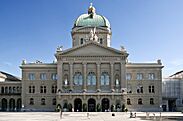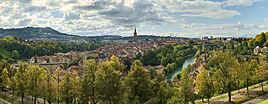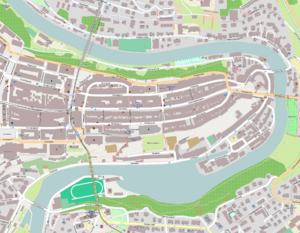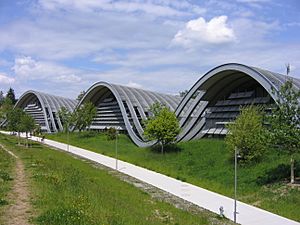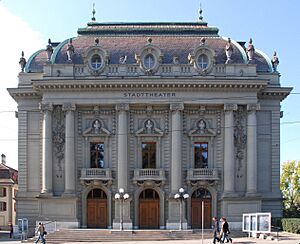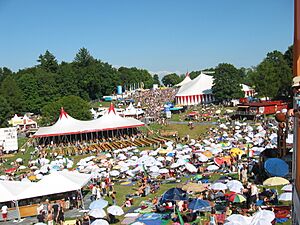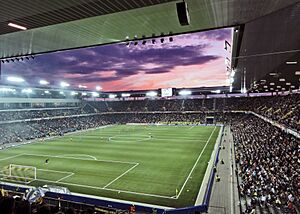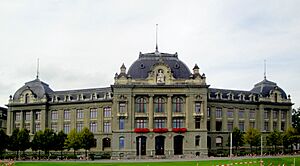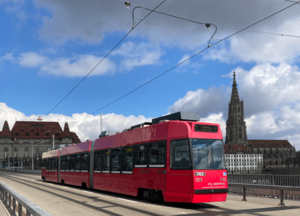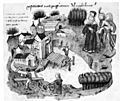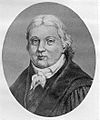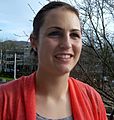Bern facts for kids
Quick facts for kids
|
|||
|---|---|---|---|
|
Municipality
|
|||
|
Aerial view of the Old City and the Aare
|
|||
|
|||
| Country | Switzerland | ||
| Canton | Bern | ||
| District | Bern-Mittelland administrative district | ||
| Area
Lua error in Module:Wd at line 1575: attempt to index field 'wikibase' (a nil value).
|
|||
| • Total | Lua error in Module:Wd at line 1,575: attempt to index field 'wikibase' (a nil value). km2 (Formatting error: invalid input when rounding sq mi) | ||
| Elevation
(Bahnhofplatz)
|
540 m (1,770 ft) | ||
| Highest elevation
(Könizberg)
|
674 m (2,211 ft) | ||
| Lowest elevation
(Aare near to Eymatt)
|
481 m (1,578 ft) | ||
| Population
(2018-12-31)Lua error in Module:Wd at line 1575: attempt to index field 'wikibase' (a nil value).
|
|||
| • Total | Lua error in Module:Wd at line 1,575: attempt to index field 'wikibase' (a nil value). | ||
| Demonym(s) | English: Bernese German: Berner(in) French: Bernois(e) Italian: Bernese |
||
| Time zone | UTC+01:00 (Central European Time) | ||
| • Summer (DST) | UTC+02:00 (Central European Summer Time) | ||
| Postal code(s) |
3000–3030
|
||
| SFOS number | Lua error in Module:Wd at line 1575: attempt to index field 'wikibase' (a nil value). | ||
| Localities | Altenberg, Aaregg, Bümpliz, Bethlehem, Beundenfeld, Bottigen, Breitenrain, Breitfeld, Brunnadern, Dählhölzli, Engeried, Gäbelbach, Grosser Bremgartenwald, Gryphenhübeli, Felsenau, Holligen, Innere Stadt, Kirchenfeld, Könizbergwald, Länggasse, Lorraine, Muesmatt, Murifeld, Neufeld, Sandrain, Schosshalde, Spitalacker, Stöckacker, Tiefenau, Wankdorf, Weissenbühl, Weissenstein | ||
| Surrounded by | Bremgarten bei Bern, Frauenkappelen, Ittigen, Kirchlindach, Köniz, Mühleberg, Muri bei Bern, Neuenegg, Ostermundigen, Wohlen bei Bern, Zollikofen | ||
| Website | SFSO statistics |
||
Bern (also called Berne) is the de facto capital city of Switzerland. People often call it the "federal city". It's the fifth-largest city in Switzerland, with about 133,000 people living there as of 2022. If you include the surrounding towns, the Bern area has over 400,000 residents.
Bern is also the capital of the canton of Bern, which is like a state in Switzerland. The main language spoken here is German, especially a local dialect called Bernese German. In 1983, the historic old town of Bern became a UNESCO World Heritage Site because of its special history and buildings. The Aare river flows around this old town, making it look very unique.
The city was founded by the Zähringer family, probably in 1191. Bern became a free city in 1218 and joined the Swiss Confederacy in 1353. Over time, Bern grew into a powerful city-state. The city was rebuilt after a big fire in 1405, giving it the look it has today. Bern became the official "Federal City" in 1848.
Contents
What's in a Name?
The name "Bern" has an interesting story, but it's not fully clear where it came from. A local legend says that Berthold V, Duke of Zähringen, who founded the city, promised to name it after the first animal he saw while hunting. That animal turned out to be a bear!
However, it's also thought that the city might have been named after the Italian city of Verona, which was called Bern in the Middle Ages. Another idea is that the name comes from an old Celtic word, *berna, meaning "cleft" or "gap".
The bear has been a symbol of Bern since the 1220s. You can even find live bears kept in the Bärengraben (bear pit) since the 1440s.
Bern's Story Through Time
How Bern Began
Scientists haven't found much proof of a town in Bern's center before the 12th century. But in ancient times, a Celtic settlement called an oppidum was located nearby. Later, during Roman times, a small town was there.
The medieval city of Bern was founded by the Zähringer family. According to old stories, Berthold V, Duke of Zähringen, started Bern in 1191. In 1218, after Berthold passed away, Bern became a "free imperial city" under the Holy Roman Emperor Frederick II. This meant it was independent and ruled itself.
Joining the Swiss Confederacy
In 1353, Bern joined the Swiss Confederacy. This made it one of the first eight cantons (like states) of Switzerland. Bern grew a lot by taking over nearby lands, like Aargau in 1415 and Vaud in 1536. This made Bern the biggest city-state north of the Alps.
The city kept growing westwards, with new towers marking its boundaries as it expanded. After a big fire in 1405, many wooden buildings were replaced with the sandstone buildings you see in the Old Town today. Even with diseases like the Black Death, Bern's population grew, mostly from people moving in from the countryside.
Bern in Modern Times
In 1798, during the French Revolutionary Wars, French troops took over Bern. It lost some of its land then. But after the Congress of Vienna in 1814, Bern got back some territories and even gained new ones.
On November 28, 1848, Bern was chosen as the "Federal City" (the seat of government) for the new country of Switzerland. It was chosen over bigger cities like Zürich and Lucerne because it was more central and was supported by French-speaking areas. However, the Swiss constitution doesn't officially call Bern the capital, just the place where the government meets.
Bern's population grew from about 5,000 people in the 1400s to over 100,000 in the 1920s. Today, it's around 142,000 people, with many foreign residents.
Bern's Location and Weather
Where Bern Is Located
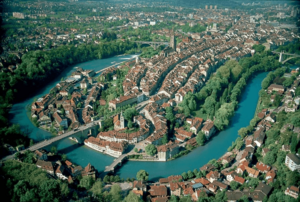
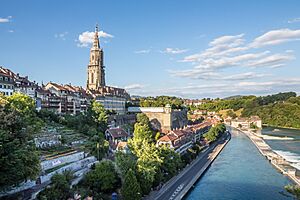
Bern is located on the Swiss plateau, a bit west of the center of Switzerland. It's about 20 kilometers (12 miles) north of the Bernese Alps. The landscape around Bern was shaped by glaciers during the last ice age.
The city was first built on a hilly piece of land almost surrounded by the Aare river. But as it grew, bridges were built to connect the city to areas beyond the river. Bern has very uneven ground, with some parts being 60 meters (200 feet) higher than others.
About a third of Bern's land is covered by forests. The city also has many parks and green spaces.
Bern's Climate
Bern has a climate that's a mix of oceanic and continental. This means it has mild summers and cold winters. The warmest month is July, with an average temperature of about 18.8°C (65.8°F). The coldest month is January, with an average of about 0.2°C (32.4°F). Bern gets a good amount of rain throughout the year and some snow in winter.
People of Bern
Bern has a population of about 134,000 people. Around 34% of the people living in Bern are from other countries. Most people in Bern speak German as their main language. Italian and French are also spoken by many residents.
In 2000, about 15% of Bern's population were children and teenagers (0-19 years old). Adults (20-64 years old) made up 65%, and seniors (over 64 years old) were about 20%.
Amazing Sights in Bern
The center of Bern, known as the Old City, is mostly medieval and is a UNESCO World Heritage Site. It's like stepping back in time!
- Zytglogge: This is a famous medieval clock tower with moving puppets. It's a must-see!
- Münster: Bern has an impressive 15th-century Gothic cathedral.
- Town Hall: You can also see a 15th-century town hall.
- Covered Shopping Arcades: The old town has about 6 kilometers (3.7 miles) of covered walkways, making it one of the longest covered shopping areas in Europe.
- Bärengraben (Bear Pit): Since the 16th century, Bern has kept bears, its symbolic animals, in a special pit. Today, the bears live in a large, open-air area nearby.
- Federal Palace (Bundeshaus): This grand building, built between 1857 and 1902, is where the Swiss parliament and government meet. You can visit it!
- Einsteinhaus: Albert Einstein lived in a flat here from 1903 to 1905. This is where he published his famous "Annus Mirabilis" papers, which included his theory of relativity.
- Rose Garden (Rosengarten): This beautiful park, once a cemetery, offers amazing views of the medieval old town.
- Fountains: The Old Town has eleven Renaissance statues on public fountains. One of the most interesting is the Kindlifresserbrunnen (Child Eater Fountain). It's a bit scary, but it's meant to be a warning to naughty children!
- Fountains in front of the Federal Palace: These modern fountains were opened in 2004.
Important Heritage Sites
Bern has 114 heritage sites of national significance. This includes the entire Old Town, which is also a UNESCO World Heritage Site.
Some of these important sites are:
- The Cathedral, started in 1421, which is the tallest cathedral in Switzerland.
- The Zytglogge and Käfigturm towers, which show how the city expanded over time.
- The Holy Ghost Church, one of the largest Swiss Reformed churches.
- The Bärengraben (bear pit).
- Several museums like the Historical Museum, Alpine Museum, Museum of Communication, and Natural History Museum.
Bern's Culture
Bern has a lively cultural scene with many theatres, cinemas, and festivals.
Theatres
- Bern Theatre
- Narrenpack Theatre Bern
- Schlachthaus Theatre
- Tojo Theater
- The Theatre on the Effinger-Street
- Theatre am Käfigturm
Cinemas
Bern has many cinemas. Films are usually shown in German, but some cinemas show movies in their original language with German and French subtitles.
Festivals
- shnit International Shortfilmfestival: A short film festival held every October.
- Queersicht: A gay and lesbian film festival in November.
- BeJazz Summer and Winter Festival
- Buskers Bern Street Music Festival
- Gurtenfestival: A popular music festival.
- Internationales Jazzfestival Bern
- Taktlos-Festival
Special Events
- Zibelemärit: The Onion Market is a yearly fair held on the fourth Monday in November.
- Bernese Fasnacht (Carnival): A fun carnival celebration.
Sports in Bern
Bern is a city that loves sports!
- Football: Bern hosted the 1954 FIFA World Cup Final. The local football team, BSC Young Boys, plays at the Stade de Suisse Wankdorf. This stadium also hosted three matches during the 2008 UEFA European Championship.
- Ice Hockey: SC Bern is the city's main ice hockey team. They play in the PostFinance Arena and are known for having the highest attendance for a European hockey team for over ten years! The PostFinance Arena also hosted the 2009 Ice Hockey World Championship.
- Baseball and Softball: The Bern Cardinals are the city's baseball and softball team.
- American Football: The Bern Grizzlies play in the top Swiss league.
- Motor Racing: The Bremgarten Circuit near Bern used to host the Swiss Grand Prix for motor racing. After a ban on motorsports, electric racing returned with the Swiss ePrix in 2019.
Bern even tried to host the 2010 Winter Olympics, but the local people voted against it.
Bern's Economy
Bern is an important economic center. In 2010, the unemployment rate was low, at 3.3%. Many people work in the service sector, which includes jobs in sales, transport, hotels, finance, education, and healthcare. Bern is a place where many people come to work from other towns. About half of the working population uses public transport to get to work.
Education in Bern
Bern is a great place for learning!
- University of Bern: This is a major university located in the city.
- Bern University of Applied Sciences: Another important school for practical studies.
- Vocational Schools: There are also several schools for learning specific trades and skills.
The school system in Bern starts with one year of optional kindergarten, followed by six years of primary school. Then, students go to three years of lower secondary school, where they are grouped by their abilities. After that, they can continue their education or start an apprenticeship.
Bern has many libraries, including the Swiss National Library and the University of Bern Library. These libraries hold millions of books and other learning materials.
Getting Around Bern
Bern has an excellent public transport system, making it easy to get around.
- Trains: Bern is a major train hub with many local and international connections. Bern's central station is one of the busiest in Switzerland.
- Trams and Buses: The city has a good network of trams, trolleybuses, and regular buses.
- Libero Tariff Network: Bern is part of a system that lets you use one ticket for all types of public transport in the region.
- Marzilibahn: This is a short funicular railway that takes you from the Marzili district up to the Federal Palace.
- Roads: Bern is well connected to other cities by major highways.
- Airport: Bern Airport mostly handles private and charter flights. Larger airports like Zurich and Geneva are a short train or car ride away.
- Bicycles: Bern is working to become a "bicycle capital" with better bike paths and a bike-sharing system called PubliBike.
Famous People from Bern
Bern has been home to many important and interesting people throughout history!
Public Figures
- Adrian von Bubenberg (around 1434–1479): A knight and mayor of Bern, known as a hero.
- Christoph von Graffenried, 1st Baron of Bernberg (1661–1743): Founded New Bern, North Carolina, in the USA.
- Kofi Annan (1938–2018): A former Secretary-General of the United Nations, who lived in Bern.
Scientists and Thinkers
- Albrecht von Haller (1708–1777): A famous scientist who studied anatomy and physiology.
- Emil Theodor Kocher (1841–1917): A doctor who won the Nobel Prize in 1909 for his work on the thyroid gland.
- Anna Tumarkin (1875–1951): The first woman to become a professor of philosophy at the University of Bern.
- Albert Einstein (1879–1955): The brilliant physicist who developed the theory of relativity while working at the patent office in Bern.
- Hans Albert Einstein (1904–1973): Albert Einstein's son, who became an engineer and educator.
Writers and Artists
- Johann David Wyss (1743–1818): Author of the famous book The Swiss Family Robinson.
- Johann Rudolf Wyss (1782–1830): Wrote the words to the former Swiss national anthem.
- Ferdinand Hodler (1853–1918): A well-known Swiss painter.
- Mani Matter (1936–1972): A popular Swiss singer-songwriter.
- Patricia Kopatchinskaja (born 1977): A talented violinist.
- Luca Hänni (born 1994): A singer-songwriter who represented Switzerland in the Eurovision Song Contest.
Sports Stars
- Tanja Frieden (born 1976): A snowboarder who won a gold medal at the 2006 Winter Olympics.
- Roman Josi (born 1990): A professional ice hockey player who plays for Switzerland.
- Jennifer Oehrli (born 1989): A football goalkeeper for the Swiss women's national team.
- Markus Ryffel (born 1955): A long-distance runner who won a silver medal at the 1984 Summer Olympics.
- Christine Stückelberger (born 1947): An equestrian who won a gold medal in dressage at the 1976 Summer Olympics.
Images for kids
-
Bern around 1870. Etching by Heinrich Müller
See also
 In Spanish: Berna para niños
In Spanish: Berna para niños


